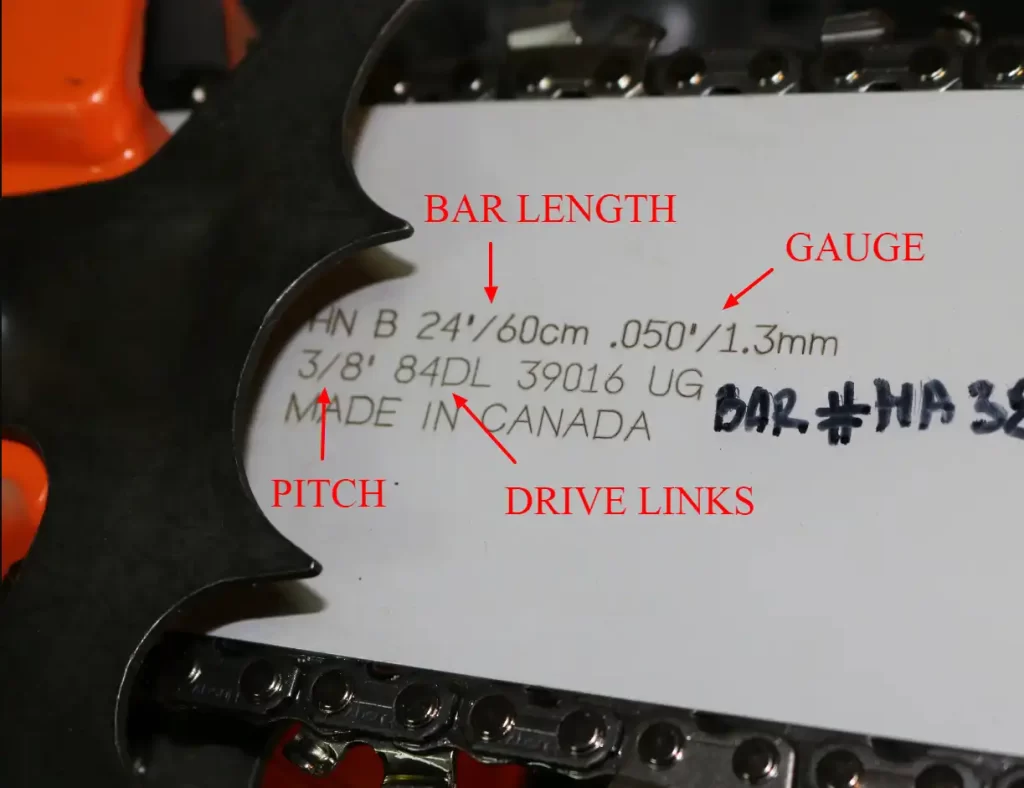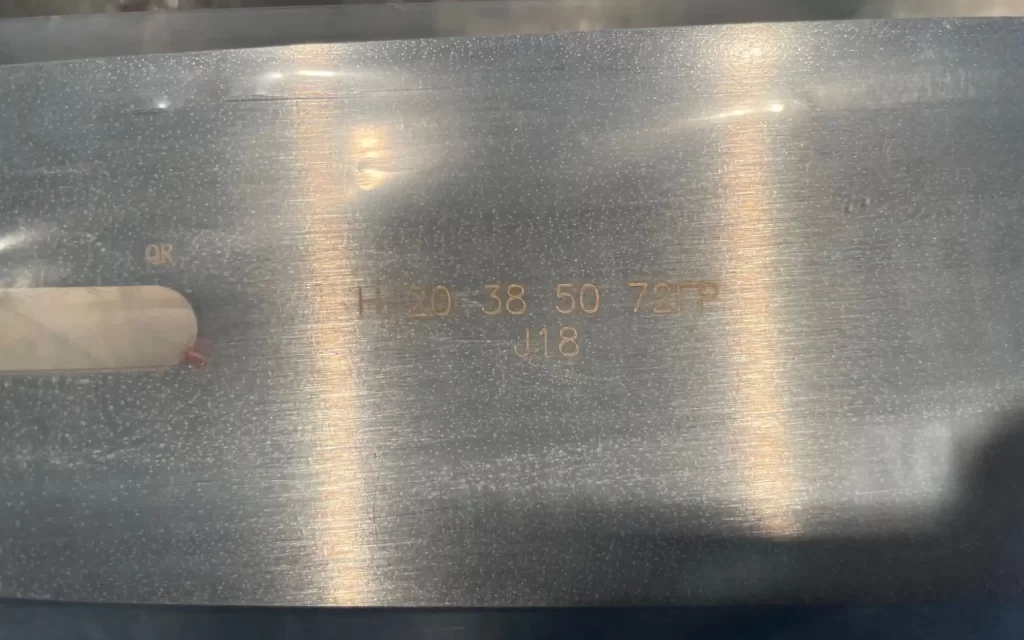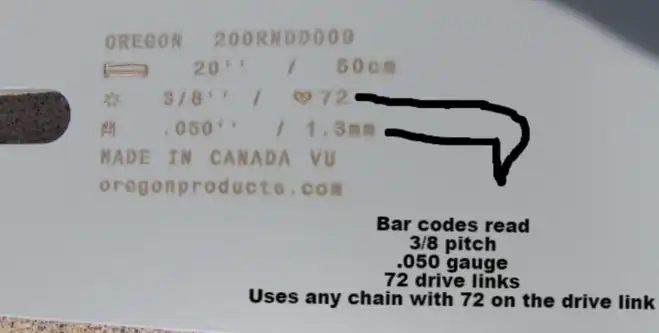The numbers on a chainsaw bar indicate the bar’s length, pitch, and gauge. These measurements ensure compatibility and optimal performance with the chainsaw chain.
Understanding the numbers on a chainsaw bar is crucial for maintenance and replacement. Chainsaw bars endure significant wear and tear, necessitating occasional replacements to maintain efficiency and safety. These numerical indicators help users select the correct bar, preventing mishaps and ensuring the saw functions smoothly.
Whether you’re a professional logger or a homeowner with backyard tasks, knowing these specifications can guide you to the right bar for your chainsaw. The right bar length enhances balance and power distribution, while accurate pitch and gauge ensure the chain fits perfectly, reducing the risk of accidents and improving cutting precision. Ensuring you have this knowledge not only optimizes your chainsaw’s performance but also extends its life span by reducing improper use and mechanical strain.

About Chainsaw Bars and Their Significance
Imagine a chainsaw without its bar – it simply would not work. The chainsaw bar is critical. It guides the chain to cut through wood smoothly and safely. Deciphering the numbers marked on this component unravels the mystery of proper saw operation and efficiency. Understanding these digits enhances performance and extends the lifespan of your chainsaw.
Understanding the Basics: The Role of the Chainsaw Bar
The chainsaw bar is more than just a piece of metal. It’s the foundation of accurate cuts. It holds the chain in place as it circles at high speeds. Selecting the right bar dictates the depth and precision of each cut.
- Length: Indicates the maximum cutting area.
- Width: Offers stability to the chain’s movement.
- Slot: Holds the chain accurately in place.
Importance of the Numbers on a Chainsaw Bar
Numbers on a chainsaw bar provide essential information. This data is vital for compatibility and performance. It dictates the fit and use of chains and drives.
| Number | Significance |
|---|---|
| Length | Size of the wood you can cut. |
| Pitch | Distance between chain links. |
| Gauge | Thickness of the drive links. |
Accurate matching of these numbers ensures optimal equipment performance. It minimizes wear and tear. With correct bar and chain pairing, you enjoy safer and more effective cutting tasks.

Decoding the Chainsaw Bar Numbers
Ready to sharpen your chainsaw knowledge? We’re diving into the important numbers etched on your chainsaw bar. These figures are not random; they hold the key to a perfect cutting experience. Understanding these numbers ensures the right fit, peak performance, and enhanced safety. So, let’s decode those chainsaw bar numbers together.
Guide Bar Length: Measurement and Implications
The length of the guide bar is the first thing you’ll notice. It tells you how long your chainsaw can cut in a single pass. This number usually ranges from 10 to over 20 inches. Choose a bar length based on your need:
- Shorter bars are great for light work and easy to control.
- Longer bars tackle big trees but need more experience to handle.
Chain Pitch: Understanding the Size of the Chain Drive Links
The chain pitch is the average distance between two drive links. It determines how the chain fits the bar. Use a ruler or download a pitch measuring tool for this task. Common pitches include:
| Pitch Size | Use Case |
|---|---|
| 1/4 inch | Detail work, carving |
| .325 inch | General cutting |
| 3/8 inch | Professional use |
Gauge Measurement: The Thickness of the Drive Links
The gauge measurement relates to the thickness of the drive links. It affects the chain’s fit in the bar’s groove. If this number is off, the chain can become too tight or slip off. Common gauges include:
- .043 inch
- .050 inch
- .058 inch
- .063 inch
Bar Code and Other Identifying Numbers
Many chainsaw bars also feature a bar code or serial numbers. It provides specifics about the bar’s manufacturer, model compatibility, and other crucial details. Always ensure these numbers match your chainsaw requirements.
Impact of Chainsaw Bar Numbers on Performance
Understanding the numbers on a chainsaw bar is crucial. They define the saw’s capabilities. The right numbers mean optimal performance. They influence how you cut and what you can do. Let’s dig into how these numbers affect a chainsaw’s performance.
Influence of Bar Length on Cutting Capacity and Maneuverability
The length of the chainsaw bar is a key factor in performance. It determines:
- What you can cut: A longer bar handles thicker trees.
- How you move: A shorter bar makes the chainsaw easier to handle.
A big tree needs a long bar. But a long bar is heavier. This can make cutting tricky. The key is balance:
| Bar Length | Use Case |
|---|---|
| Short Bar (10″-14″) | Trimming, Pruning |
| Medium Bar (16″-20″) | General Cutting, Felling Small Trees |
| Long Bar (22″+) | Felling Large Trees, Thick Logs |
Compatibility of Chain Pitch and Gauge With Overall Efficiency
Chain pitch and gauge also impact efficiency. Proper fit equals smooth cuts. You get:
- Less wear: On the chainsaw and the chain.
- More power: From the saw, translating to cleaner cuts.
- Improved safety: With the chain snug on the bar.
Match these numbers to your chainsaw for the best results:
| Chain Pitch | Chain Gauge | Efficiency Benefit |
|---|---|---|
| Small (1/4″, .325″) | Thin (.043″, .050″) | Light cutting, less power needed |
| Large (3/8″, .404″) | Thick (.058″, .063″) | Heavy cutting, with high power |
Selecting the Right Bar Numbers for Specific Jobs
Choose the right bar numbers for the task:
- Assess the job: What are you cutting?
- Check your saw: What sizes fit it?
- Balance: Consider both cutting needs and chainsaw specs.
Bar numbers are guides. They lead to a safer, smoother, and more efficient cut.
Know more: How to Know What Size File for Chainsaw
Maintenance and Safety Considerations
Understanding the numbers on your chainsaw bar is crucial. It’s more than just sizes and measurements; it’s about your safety and your chainsaw’s longevity. Proper maintenance and safety measures ensure your chainsaw operates smoothly and safely, minimizing the risk of accidents or wear and tear. Here we’ll guide you through the routine care for chainsaw bars, vital safety precautions, and troubleshooting tips for chain and bar compatibility.
Routine Care For Chainsaw Bars Based On Specs
- Inspect the bar regularly for signs of wear or damage.
- Clean the bar’s groove to remove sawdust and debris.
- Flip the bar periodically to evenly distribute the wear.
- Check the bar’s oiling holes to ensure they are not clogged.
- Measure the bar to confirm it matches the chainsaw’s power and usage.
- File down burrs on the bar’s edges to maintain a smooth surface.
- Lubricate the bar and chain to reduce friction and prevent overheating.
Safety Precautions Related to Bar and Chain Measurements
Your chainsaw is powerful, and the right numbers on the bar guide you to use it safely. Heed these precautions:
- Wear protective gear like gloves, glasses, and ear protection.
- Confirm the bar length fits the saw and your project’s requirements.
- Match the chain pitch and gauge to the bar’s specifications without fail.
- Ensure proper tension of the chain to prevent it from slipping off the bar.
- Avoid kickback, which can occur if the bar is the wrong size or poorly maintained.
- Never use a damaged bar as it compromises the chainsaw’s safety features.
Troubleshooting Common Issues With Chain and Bar Compatibility
When issues arise, be ready to diagnose and fix them. Here are some common solutions:
- Chain won’t rotate: Check for correct tension and proper bar oiling.
- Uneven cuts: Ensure the bar is not bent or worn on one side.
- Excessive vibration: Verify that the chain and bar measurements align.
- Chain jumps off the bar: This often means a need for tension adjustment.
- Rapid wear: A mismatch in bar and chain specs can lead to accelerated aging.
- Difficult cutting: Dull chain or incorrect bar length could be the culprit.
Regular assessment of these components prevents most compatibility issues.

Conclusion
Understanding chainsaw bar numbers is essential for optimal performance and safety. These figures indicate bar length, pitch, and gauge, ensuring you choose the right chain. Armed with this knowledge, you can tackle any cutting task confidently. Remember, selecting the proper equipment enhances both efficiency and longevity.
Maintain your chainsaw wisely, and let those numbers guide you to seamless operation. Keep exploring the world of chainsaws with us at Chainsaw Hive. Our Knowledge section is brimming with insights just for you.
